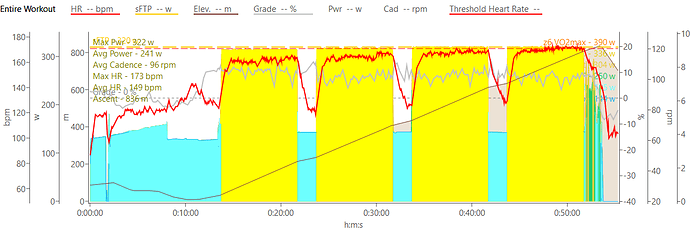Hi everyone, sorry to be slow to pipe in here. Interesting discussion and debate. The conversation is quite long, so I’ll try to address everything I was tagged on, but I apologize if I missed something. Hope this gives some answers:
Execution
I do differ from Dr Seiler just slightly on these. In his studies, he had athletes do them as hard as they could while keeping the power consistent across all intervals. Since I use these in the base season, I focus more on keeping them around MLSS. Again, as you pointed out above, it’s not a specific number (i.e. going from 100% to 101% isn’t going to make a difference.) So, I give my athletes a few criteria:
- Power should be in a range that is sustainable from interval to interval
- But I don’t just prescribe power - heart rate and RPE are just as important if not more important. I give my athletes an upper limit on their heart rate that’s 1 BPM above their threshold. They aren’t allowed to go above that. The right wattage is what gets them to that heart rate by the third and fourth interval without going over.
- Following those rules, the power is going to vary from session to session. For example, one session you may do 290 watts, the next session, you may find you have to back down to 280 watts and then the next time you may feel great and do 300 watts.
- While my prescription is different from Dr Seiler’s I do find the end result is very similar. Using my prescription, most athletes find they are going as hard as they can by the fourth interval and wouldn’t have been able to go much harder if they had set a goal of hitting the same wattage in all four intervals.
Here’s an example of a session I did this winter to show you what I mean:
Notice the power is the same each session. Also notice that I don’t hit the upper limit on my heart rate (dotted red line) until the third and fourth intervals.
How Hard Should These Feel
This is a really important point that we’ve been trying to communicate on the show lately. The focus of our work should be on targeting energy systems. Using “I really suffered” as a gauge is often a bad gauge. To hit many of our energy systems effectively, intervals SHOULDN’T be as hard as possible.
In the case of these intervals, they should hurt and the final interval should be a bit of a struggle, but overall, you should get through them feeling like you could have gone harder. I found it interesting that you mentioned the workout is only about 60-70 TSS. Here’s my data for the workout above:

I did70 TSS not just for the intervals but the entire workout and I was very happy with that workout.
I’ll also mention that I did a combination of 5x5s and 4x8s from the start of December to mid-March this year. I was doing them twice per week and most of those workouts were in the 70-80 TSS range. My wattage for the intervals from early December to mid-March improved about 60 watts. So, I was quite happy with both the execution and the results.
Final note - I actually just recorded two videos this morning on how to execute both 5x5s and 4x8s. Those videos should be on the site in a week or two.


